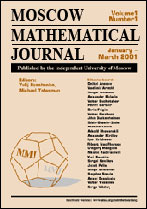|
This article is cited in 4 scientific papers (total in 4 papers)
Quasi-ordinary singularities and Newton trees
E. Artal Bartoloa, Pi. Cassou-Noguèsb, I. Luengoc, A. Melle Hernándezd
a Departamento de Matemáticas-IUMA, Universidad de Zaragoza, c/ Pedro Cerbuna 12, 50009 Zaragoza, Spain
b Institut de Mathématiques de Bordeaux, Université Bordeaux I, 350, Cours de la Libération, 33405, Talence Cedex 05, France
c Dept. of Algebra, Facultad de Ciencias Matemáticas, Universidad Complutense, 28040, Madrid, Spain
d ICMAT (CSIC-UAM-UC3M-UCM), Dept. of Algebra, Facultad de Ciencias Matemáticas, Universidad Complutense, 28040, Madrid, Spain
Abstract:
In this paper we study some properties of the class of $\nu$-quasi-ordinary hypersurface singularities. They are defined by a very mild conditions on their (projected) Newton polygon. We associate with them a Newton tree and characterize quasi-ordinary hypersurface singularities among $\nu$-quasi-ordinary hypersurface singularities in terms of their Newton tree. A formula to compute the discriminant of a quasi-ordinary Weierstrass polynomial in terms of the decorations of its Newton tree is given. This allows to compute the discriminant avoiding the use of determinants and even for non Weierstrass prepared polynomials. This is important for applications like algorithmic resolutions. We compare the Newton tree of a quasi-ordinary singularity and those of its curve transversal sections. We show that the Newton trees of the transversal sections do not give the tree of the quasi-ordinary singularity in general. It does if we know that the Newton tree of the quasi-ordinary singularity has only one arrow.
Key words and phrases:
quasi-ordinary singularities, resultant, factorization.
Received: July 29, 2010; in revised form February 15, 2012
Citation:
E. Artal Bartolo, Pi. Cassou-Noguès, I. Luengo, A. Melle Hernández, “Quasi-ordinary singularities and Newton trees”, Mosc. Math. J., 13:3 (2013), 365–398
Linking options:
https://www.mathnet.ru/eng/mmj501 https://www.mathnet.ru/eng/mmj/v13/i3/p365
|

| Statistics & downloads: |
| Abstract page: | 136 | | References: | 58 |
|




 Contact us:
Contact us: Terms of Use
Terms of Use
 Registration to the website
Registration to the website Logotypes
Logotypes







 Citation in format
Citation in format 
